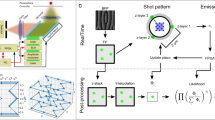Abstract
We introduce a graphical model for the joint segmentation and tracking of E. coli cells from time lapse videos. In our setup cells are grown in narrow columns (growth channels) in a so-called “Mother Machine” [1]. In these growth channels, cells are vertically aligned, grow and divide over time, and eventually leave the channel at the top. The model is built on a large set of cell segmentation hypotheses for each video frame that we extract from data using a novel parametric max-flow variation. Possible tracking assignments between segments across time, including cell identity mapping, cell division, and cell exit events are enumerated. Each such assignment is represented as a binary decision variable with unary costs based on image and object features of the involved segments. We find a cost-minimal and consistent solution by solving an integer linear program. We introduce a new and important type of constraint that ensures that cells exit the Mother Machine in the correct order. Our method finds a globally optimal tracking solution with an accuracy of > 95% (1.22 times the inter-observer error) and is on average 2 − 11 times faster than the microscope produces the raw data.
Access this chapter
Tax calculation will be finalised at checkout
Purchases are for personal use only
Preview
Unable to display preview. Download preview PDF.
Similar content being viewed by others
References
Wang, P., Robert, L., Pelletier, J., Dang, W., Taddei, F., Wright, A., Jun, S.: Robust growth of E. coli. Current Biology 20(12), 1099–1103 (2010)
Jug, F., Pietzsch, T., Preibisch, S., Tomancak, P.: Bioimage informatics in the context of Drosophila research. Methods (2014)
Padfield, D., Rittscher, J., Roysam, B.: Coupled Minimum-Cost Flow Cell Tracking. In: Prince, J.L., Pham, D.L., Myers, K.J. (eds.) IPMI 2009. LNCS, vol. 5636, pp. 374–385. Springer, Heidelberg (2009)
Padfield, D., Rittscher, J., Roysam, B.: Coupled minimum-cost flow cell tracking for high-throughput quantitative analysis. Medical Image Analysis 15(4), 650–668 (2011)
Kausler, B.X., et al.: A Discrete Chain Graph Model for 3d+t Cell Tracking with High Misdetection Robustness. In: Fitzgibbon, A., Lazebnik, S., Perona, P., Sato, Y., Schmid, C. (eds.) ECCV 2012, Part III. LNCS, vol. 7574, pp. 144–157. Springer, Heidelberg (2012)
Funke, J., Anders, B., Hamprecht, F., Cardona, A., Cook, M.: Efficient automatic 3D-reconstruction of branching neurons from EM data. In: CVPR. IEEE (2012)
Schiegg, M., Hanslovsky, P., Kausler, B., Hufnagel, L.: Conservation Tracking. In: ICCV (2013)
Kolmogorov, V., Boykov, Y., Rother, C.: Applications of parametric maxflow in computer vision. In: ICCV, pp. 1–8. IEEE (2007)
Breiman, L.: Random Forests. Machine Learning 45(1), 5–32 (2001)
Jones, R.: Component trees for image filtering and segmentation. In: IEEE Workshop on Nonlinear Signal and Image Analysis (1997)
Nistér, D., Stewénius, H.: Linear Time Maximally Stable Extremal Regions. In: Forsyth, D., Torr, P., Zisserman, A. (eds.) ECCV 2008, Part II. LNCS, vol. 5303, pp. 183–196. Springer, Heidelberg (2008)
Blake, A., Kohli, P., Rother, C.: Markov Random Fields for Vision and Image Processing. MIT Press (2011)
Arganda-Carreras, I., Cardona, A., Kaynig, V., Schindelin, J.: Trainable weka segmentation (May 2011), http://fiji.sc/Trainable_Weka_Segmentation
Frey, B., Kschischang, F., Loeliger, H., Wiberg, N.: Factor graphs and algorithms. In: Proceedings of the Annual Allerton Conference on Communication Control and Computing, vol. 35, pp. 666–680 (1997)
Schrijver, A.: Theory of Linear and Integer Programming. J. Wiley & Sons (1998)
Author information
Authors and Affiliations
Editor information
Editors and Affiliations
Rights and permissions
Copyright information
© 2014 Springer International Publishing Switzerland
About this paper
Cite this paper
Jug, F. et al. (2014). Optimal Joint Segmentation and Tracking of Escherichia Coli in the Mother Machine. In: Cardoso, M.J., Simpson, I., Arbel, T., Precup, D., Ribbens, A. (eds) Bayesian and grAphical Models for Biomedical Imaging. Lecture Notes in Computer Science, vol 8677. Springer, Cham. https://doi.org/10.1007/978-3-319-12289-2_3
Download citation
DOI: https://doi.org/10.1007/978-3-319-12289-2_3
Publisher Name: Springer, Cham
Print ISBN: 978-3-319-12288-5
Online ISBN: 978-3-319-12289-2
eBook Packages: Computer ScienceComputer Science (R0)




